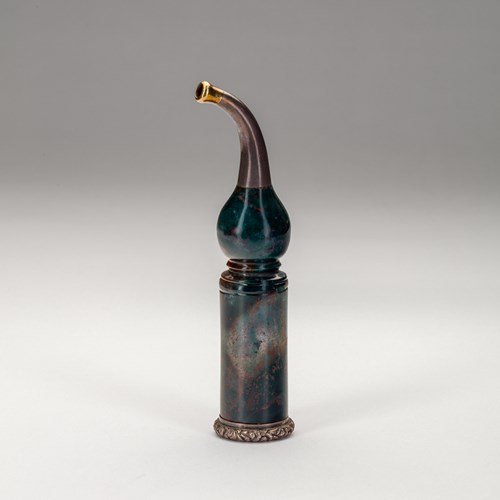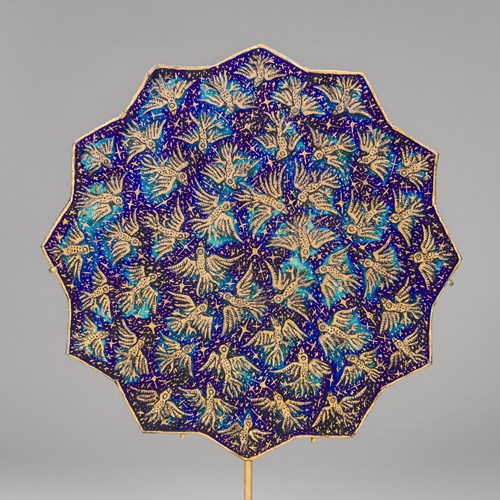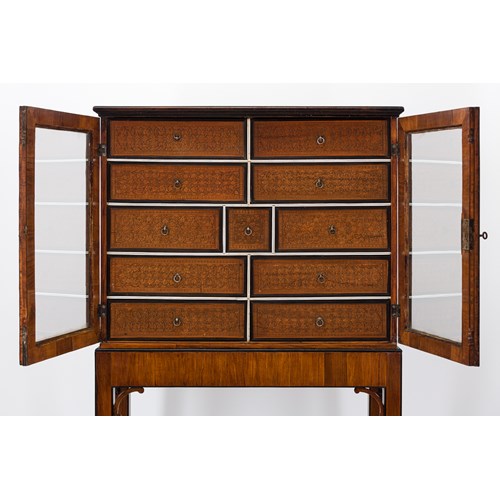Marketplace
Tile Panel Depicting Virgin Mary and Child
Tile Panel Depicting Virgin Mary and Child
Date 19th century
Epoque 1750-1850, 1850-1900, 19th century
Origine Turkey, Kütahya
Medium Pottery
Dimension 8.6 x 23.9 cm (3³/₈ x 9³/₈ inches)
This panel is composed of two pottery tiles depicting the icon of Virgin Mary holding child Jesus. The Virgin Mary is painted on the top tile in purple, black, green, red and underglaze blue. On her covered head she is wearing a crown, surrounded by an illuminating halo with two angels in the top right and left-hand corners. The child Jesus is seated on the Virgin Mary’s lap and is depicted with black hair and an illuminating halo with three Greek characters which translate to ‘He Who Is’.[1] The lower tile depicts the Virgin Mary’s dress in underglaze blue, yellow and red and the Child is depicted in purple and red dress with the Holy Book in his left hand. Two fingers on his right hand are outstretched in a gesture of blessing. The border of the tile has a red and underglaze blue chevron border.
Following the demise of Iznik pottery and production in the 17th century, pottery work continued to be produced in Kütahya (Porter, p. 111). We are reasonably able to determine the various types of Kütahya wares which were produced in this region (in western Turkey on the Porsuk River - about 200km southeast of Istanbul) including bowls, plates, jugs and also tiles with winged angels and icons of the Virgin Mary and Child (Porter, p. 116). The most important works from this series can be found in the Armenian Cathedral of St James in Jerusalem (1718-19; Porter, p. 116).
Two nearly identical Kütahya tiles depicting a closely matching icon (with variations in colours) of the Virgin Mary and Child are in The British Museum, London, Accession Number 1928,1017.1, decorated in underglaze blue, red, yellow and black (see Porter, p. 115, fig. 106).
[1] Exodus 3:14King James Version (KJV)14 And God said unto Moses, I Am That I Am: and he said, Thus shalt thou say unto the children of Israel, I Am hath sent me unto you.
Following the demise of Iznik pottery and production in the 17th century, pottery work continued to be produced in Kütahya (Porter, p. 111). We are reasonably able to determine the various types of Kütahya wares which were produced in this region (in western Turkey on the Porsuk River - about 200km southeast of Istanbul) including bowls, plates, jugs and also tiles with winged angels and icons of the Virgin Mary and Child (Porter, p. 116). The most important works from this series can be found in the Armenian Cathedral of St James in Jerusalem (1718-19; Porter, p. 116).
Two nearly identical Kütahya tiles depicting a closely matching icon (with variations in colours) of the Virgin Mary and Child are in The British Museum, London, Accession Number 1928,1017.1, decorated in underglaze blue, red, yellow and black (see Porter, p. 115, fig. 106).
[1] Exodus 3:14King James Version (KJV)14 And God said unto Moses, I Am That I Am: and he said, Thus shalt thou say unto the children of Israel, I Am hath sent me unto you.
Date: 19th century
Epoque: 1750-1850, 1850-1900, 19th century
Origine: Turkey, Kütahya
Medium: Pottery
Dimension: 8.6 x 23.9 cm (3³/₈ x 9³/₈ inches)
Provenance: USA Museum Deaccession
Literature: Kürkman, G. Magic of Clay and Fire: A History of Kütahya Pottery and Potters, Suna and Inan Kiraç Foundation, Istanbul, 2006.
Porter, V. Islamic Tiles, The British Museum Press, London, 1995.
Plus d'œuvres d'art de la Galerie







_T638295248852049140.jpg?width=500&height=500&mode=pad&scale=both&qlt=90&format=jpg)

_T638793797436904297.jpg?width=500&height=500&mode=pad&scale=both&qlt=90&format=jpg)